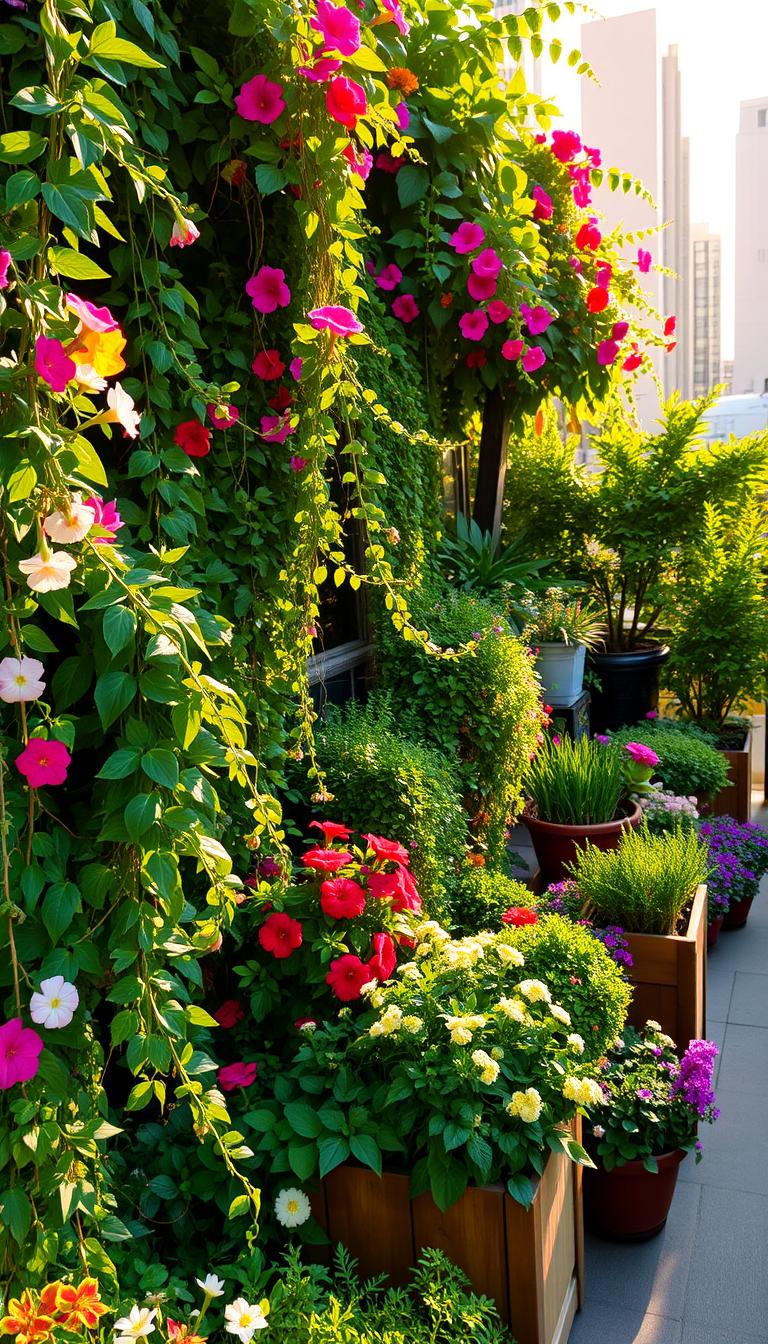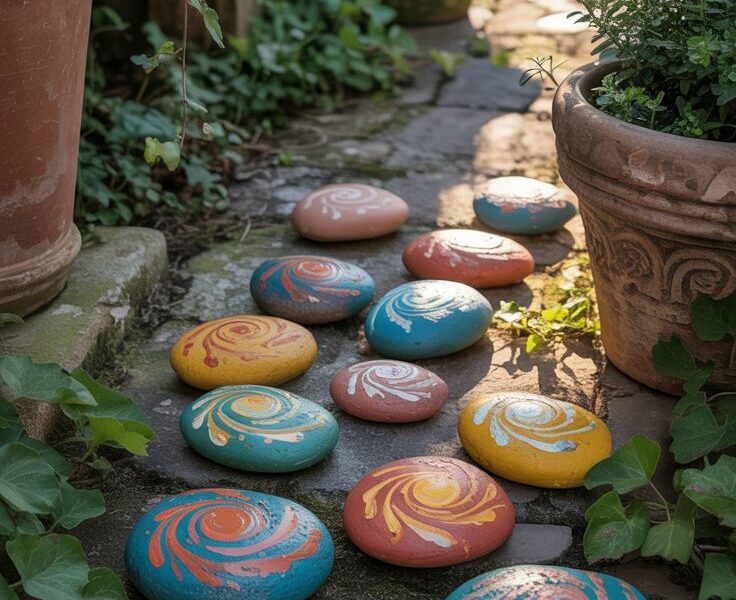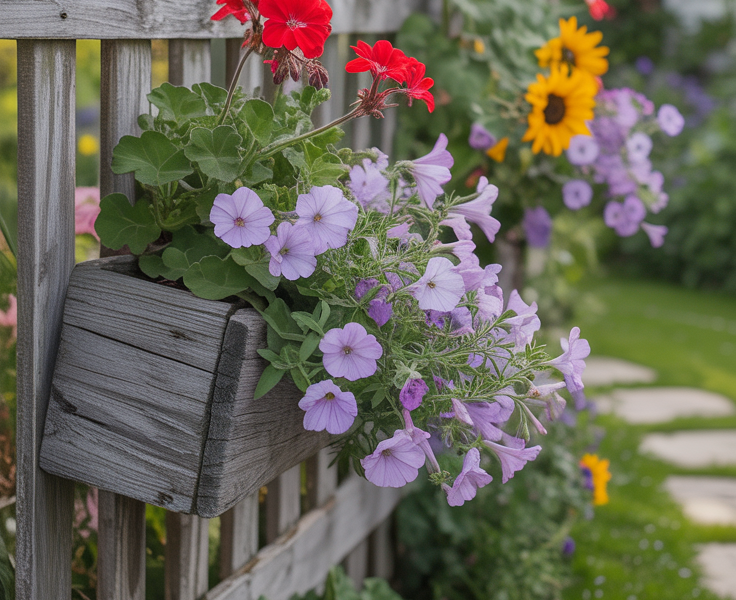Did you know 80% of Americans live in cities? But, only about 5% garden in these places. This shows a big chance to make our cities greener.
Small-space gardening is more than a trend. It’s a big change. By learning to garden in small spaces, you’re starting a new way of life. You can grow everything from tomatoes to herbs, just like in the countryside.
Want to trade city air for the smell of flowers? Let’s learn how to make your balcony or patio a lush garden, even if it’s small.
Key Takeaways
- Urban gardening transforms small spaces into green oases
- Container gardening is ideal for balconies and patios
- Vertical gardening maximizes limited space
- Dwarf fruit trees and berries thrive in small areas
- Self-watering containers ensure consistent plant care
- Wind-tolerant plants are key for balcony gardens
Understanding the Basics of Urban Gardening
Urban farming is getting more popular. More city people are starting gardens. Whether it’s a balcony garden or a patio oasis, knowing the basics is important.
Benefits of Growing a Garden in the City
Gardening in the city has many benefits. It can make you feel less stressed and happier. You can grow your own food and save money.

Space Assessment and Planning
Every balcony garden is different. Make yours fit your space. Think about sunlight, wind, and how much things can weigh.
For sunny spots, pick plants that love the sun. Shady areas need plants that don’t mind the shade. Vertical gardens and planters help use up small spaces.
Essential Urban Gardening Tools
Get the right tools for gardening. You’ll need:
- Pots and containers with proper drainage
- Quality potting soil
- Watering can or hose
- Pruning shears
- Gardening gloves
- Organic fertilizers
With these tools, you’re set to create a beautiful garden. Start small, learn as you go, and watch your garden grow!
Analyzing Your Growing Environment
To make your urban garden grow well, you need to know your space. Whether you’re setting up vertical gardening or edible landscaping, checking your area is key. It’s important for a green city life.
Determining Sun Exposure
Watch how sunlight falls on your balcony or patio. South sides might need shade, while north sides might need more light. Knowing this helps pick the best plants and where to put them.
Wind and Temperature Considerations
Urban gardens have special challenges. Balconies get strong winds that dry out plants fast. Heat from hard surfaces also affects soil moisture. Use big pots and special granules to help.

Weight Restrictions and Safety
Remember your balcony’s weight limit. Big pots with soil can be heavy. Make sure they drain well to protect your plants and the building.
Choose light materials for vertical gardens to stay safe and use space well.
- Use AI and IoT to monitor soil moisture, temperature, and light levels
- Choose plants based on your balcony’s orientation and climate
- Maximize space with clever container choices and arrangements
- Optimize water and nutrient use to reduce waste
- Manage pests and diseases with organic, sustainable methods
By looking at these points, you can make a green, productive urban garden. It will do well in your special place.
Urban Gardening 101: How to Grow a Lush Balcony or Patio Garden

Creating urban green spaces is easier than you think! You can turn your balcony or patio into a garden oasis. Start by picking plants that fit your space and climate. Mix perennials for long-term greenery with annuals for seasonal color.
For small spaces, consider these options:
- Dwarf fruit trees like Meyer Lemon or columnar Apple
- Herbs such as basil, rosemary, and thyme
- Compact vegetables like cherry tomatoes
- Flowering plants including geraniums and lavender
Think vertically to make the most of your space. Use trellises, hanging baskets, and wall-mounted planters. This saves space and adds interest to your garden.
Don’t forget about container selection. Mix sizes and styles for depth. Make sure all containers drain well to keep plants healthy. Follow these tips and you’ll have a lush garden to enjoy!
Choosing the Right Containers and Materials
Urban farming and container gardening are great together. The secret to success is picking the right pots and materials. Let’s explore how to make a green oasis in your city home.
Container Types and Sizes
For small-space gardening, having many options is good. Here are some:
- Clay pots for plants that like dry air
- Plastic containers for plants that love water
- Raised beds for more space
- Fabric grow bags for easy moving
- Window boxes for herbs
Make sure your containers have holes for water to drain. Pots on wheels are great for moving. Dark pots keep warm, while light ones keep roots cool.

Soil Selection and Preparation
Good soil is the base of your urban farm. Don’t use garden soil. Instead, choose a high-quality potting mix. It helps plants breathe and hold nutrients well, key for container gardening success. Add a slow-release fertilizer to feed your plants over time.
Drainage Solutions
Drainage is key in small-space gardening. Make sure your containers have holes at the bottom. Use trays to catch water and prevent damage. Adding mulch helps keep soil moist and the right temperature for your urban farm.
Smart Plant Selection for Small Spaces

You don’t need a lot of land for a great balcony garden or patio garden. Smart plant picking can turn even the smallest spot into a green paradise. The trick is to pick plants that use your space well and make your outdoor area pretty and useful.
For your balcony, think about using dwarf trees and columnar plants. They give you greenery without taking up too much room. Miniature roses, dwarf fountain grass, and dwarf coneflowers add color in small pots. If you don’t have much floor space, try hanging baskets and vertical gardens to add more greenery to your patio.
Edible landscaping is a great idea for your urban garden. Dwarf fruit trees like the Improved Dwarf Meyer Lemon or columnar apple trees are perfect for small areas. Herbs and veggies in pots bring fresh food right to you. Try growing parsley, chives, cilantro, and mint for a fragrant and handy garden.
- Shade-loving plants: Hostas, ferns, and coral bells
- Low-maintenance options: Snake plant, pothos, rosemary, thyme
- Vertical gardening: Monstera, pothos, hoya on moss poles or wall-mounted pots
- Tropical flair: Banana trees and elephant ears
Your balcony garden is more than just pretty. It can help you relax, feel better, and work better. With these smart plant choices, you’ll make a lovely and helpful urban oasis fast.
Vertical Gardening Techniques
Vertical gardening turns small spaces into art. It grows plants up, using every inch. It’s great for places like patios and balconies where space is tight.
Wall-Mounted Systems
Living walls add life to empty walls. You can buy systems or make your own. They’re perfect for greens, herbs, and small veggies like Early Gola Cabbage.
Hanging Gardens
Hanging planters use vertical space well. Hang baskets from balconies or patios. They’re great for herbs or veggies like Methi and Palak.

Trellises and Support Structures
Trellises make plants grow up like curtains. Train plants like Surina French Beans to climb. Try columnar apple trees like Blushing Delight for a fruit twist.
Vertical gardening does more than save space. It adds shade, privacy, and beauty. With these methods, you can make a lush garden in any small city spot.
Water Management and Irrigation Systems
Keeping water use low is key for urban farming and container gardening. Smart irrigation systems help your garden grow well. They also support living in a green way.
Watering Schedules
Make a watering plan that fits your plants’ needs. Drip irrigation systems send water right to the roots. This cuts down on water lost to air.
It’s great for people with little time. They save water and effort.
Self-Watering Solutions
Self-watering containers are a big help for container gardening. They have special water tanks that keep soil moist. This is perfect for those with busy lives.
They cut down on how often you need to water. And they stop you from watering too much.

Rainwater Collection
Collecting rainwater is a smart move for your urban garden. Put a small rain barrel on your balcony to catch rain. This green choice cuts down on tap water use.
It also stops water from running off. Rainwater is usually better for plants than city water.
Don’t forget to use mulch in your containers. It keeps the soil moist and stops water from evaporating. For plants that can get root rot, use potting mix with perlite. These tips will help you manage water well in your urban garden.
Seasonal Maintenance and Care

Urban gardening 101 teaches you to care for your garden all year. It’s important for a green space in the city. Choose plants that fit your area and change with the seasons.
In spring and summer, plants grow fast. Water them often because pots dry out fast. Use a slow-release fertilizer. Also, remove dead flowers and watch for bugs.
When fall comes, get ready for cooler weather. Move soft plants inside or cover them. In winter, water less and protect roots from cold. Use this time to plan your garden for next year.
Here are some tips for your garden all year:
- Use containers with good drainage
- Apply mulch to retain moisture and regulate soil temperature
- Rotate seasonal plants for continuous blooms
- Prune regularly to maintain plant health
- Consider casters on planters for easy relocation
Your garden will grow well in every season. It will make your city home happier and more fruitful. Urban gardening is all about learning and trying new things!
Conclusion
Urban gardening is more than a hobby. It’s a big change in city living. In NYC, balcony gardens have grown by 15% in five years. You can make your balcony or patio a green oasis too.
In L.A., 30% of patio owners grow herbs. In Chicago, 25% grow vegetables. Your garden can be both pretty and useful. You can use vertical gardens or containers, even in places like Houston that save water.
You can start small with herbs or flowers. Soon, you might have a big garden. Setting up a small garden is a great start. Every plant helps make cities greener and more sustainable. So, get ready to make your city corner bloom!


